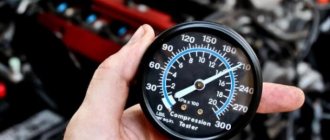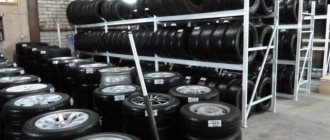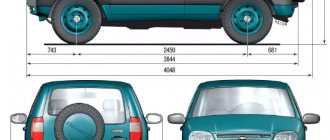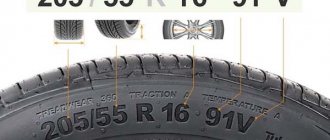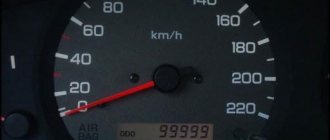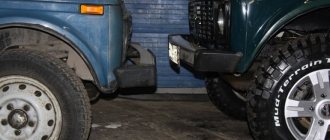Tires can be called the link between the car and the road surface. That is why the composition and design of tires has been constantly improved over many decades. According to accepted rules, a car is allowed to participate in road traffic only if the wheels are in proper condition. Inspecting tires from all sides allows you to obtain information about their condition, the technical condition of the car and the characteristics of the owner’s driving style.
Why it eats rubber is a fairly common question that can be found on various automotive forums. After all, some time after uneven wear is detected, the wheels may be unsuitable for use, since severe wear significantly impairs handling, increases braking distance, and reduces vehicle stability on the road.
Why does a car eat rubber on the outer and inner sides of the front wheels? Read and eliminate
Many car enthusiasts are interested in why the car eats rubber on the outer and inner sides of the front wheels. This problem is quite common. Moreover, the difficulty lies in the inability of the craftsmen to accurately determine the cause of the breakdown, but it always lies on the surface. Therefore, it is advisable for the owner to know the main types of breakdowns that lead to increased wear of parts. Some of the problems can be fixed right in the garage. This will allow you to avoid unnecessary trips to the service center, although no one has canceled the diagnosis. By knowing the reasons, you can avoid mistakes made by careless or inept mechanics.
Why does a car eat rubber on the outer and inner sides of the front wheels? Everyone knows that car tires wear out over time, and this primarily concerns the front wheels. There are several factors that influence this process. Actually, not too much tire wear is normal for a car. The tires on the inside of the wheel are worn off first. This is due to the presence of castor. In theory, under normal conditions, wear on a wheel becomes noticeable only after 2-3 seasons. With faster wear, it is necessary to look for the cause of the problem.
Common problems
When considering why the Fiat Albea has tires with varying degrees of wear, it should be noted that in some cases the problem manifests itself after several hundred kilometers of travel. Let us highlight the following reasons why rubber is consumed unevenly:
- Incorrect alignment, which can occur after some time of operation of the vehicle and with a strong impact. Internal wear often occurs for this reason. Therefore, many people pay attention to it when checking the tread.
- Incorrect tire pressure can also be cited as the reason why wear occurs on the inner or outer side after some time.
- Low pressure can also cause uneven wear. Those who like to ride on flat tires constantly change their tires.
- Defects in manufacturing. It is quite rare to encounter a situation where the cause of the phenomenon in question is a manufacturing defect. That is why you should pay attention when choosing to offer only trusted manufacturers.
- Tire aging. It is quite rare for tires to be used after they have been manufactured for several years. This is due to the fact that a large number of cars determines a high need for the product in question. Therefore, all tires are bought up quite quickly.
There are quite a lot of answers about what is eating rubber. A Fiat or other car should be checked according to a certain scheme to identify the problem. This is due to the fact that even a simple reason that takes little time and effort to eliminate can lead to significant problems.
Why does it eat the tire from the outside front or rear?
More often the cause of such a defect is a broken camber. If its angle is too positive, excessive abrasion of the outer shoulders of the rubber is observed. The final conclusion is made only after examining the suspension parts, the essence of which we outlined in the previous section.
If the wheel alignment is set, the suspension is “normal”, but the rubber is still eating from the outer edge, then the problem is with the tires. There are plenty of examples of when it is enough to replace a set of tires with a new one, and problems with tread development at the rear and front immediately disappear.
For example, the Kama Euro 129 is distinguished by its fat on the outside: after 1,000-2,000 km, uneven tire geometry is observed. And this is another nail in the list of their shortcomings, although they are already not the most wear-resistant summer tires with a strong sidewall among the participants in the fresh test.
Briefly about the main thing
| Character zhora wheel | Cause |
| Evenly from inside | Broken camber, problems with suspension, wheel bearing, defective tire. |
| Eats away the edge with a step (saw) | Incorrect alignment, worn (deformed) suspension, defective tire. |
| Along the outer contour | The camber was knocked down, there were cases of cornering at high speed, the chassis was damaged, and tires were defective. |
| Along the edges | Reduced air pressure in the tire. |
| Centered | Increased air pressure in the tire. |
| Lumps | Wheel imbalance. |
Methods for eliminating the causes of wear on truck and bus tires
To increase the life of truck and bus tires, you need to know the basic types of tire care. These include:
- wheel chamber pressure control;
- monitoring the external condition of the tire;
- control of location and operating mode.
A tire in normal condition has the following characteristics: there is a cap on the valve, there are no deep cuts on the tread, and there are no protruding threads. Before driving, you need to inspect the wheels to identify the presence of sharp objects in the tires.
It is very important to choose the right route. Road surfaces interspersed with stones significantly increase the wear rate of truck and bus tires. Do not overload the machine. Avoid sudden acceleration, frequent heavy braking, and maneuvering at high speeds. If the vehicle needs to be parked for a long time, it is recommended to inflate the tires to increase the pressure in them. When installing new tires, the wheels should be balanced.
Recommendations for extending tire life
Regardless of what the cause of tire wear was in your case, there are several simple recommendations that, if followed, will allow you to increase the life of your tires (no matter winter or summer). These include:
Measuring tread wear depth with a coin
- Correct tire pressure
. Its value must be checked approximately once every two to three weeks, and, if necessary, adjusted (pumped). Remember that low pressure not only wears out tires excessively, but also increases fuel consumption, and therefore your money. - Serviceable suspension
. Serviceable shock absorbers are not only synonymous with a comfortable ride, but also with low tire wear. Monitor their condition and, if necessary, repair or replace them. - Selecting the correct speed mode
. This is one of the most important factors affecting tire wear. Firstly, the faster the car drives (the wheel rotates), the faster the tires go bald. Secondly, when the car rolls in a turn at high speed, wear occurs on the outer and even side surface of the tire. Always adhere to the speed limit and try not to start or brake suddenly (and even more so with slipping or skidding). - Buy good tires
. We are not talking about expensive world famous brands. But it’s also not worth purchasing frankly low-quality tires. There is a high probability that such a tire will not last long. This means that you will have to go to the store again. Everyone knows the saying “the miser pays twice.” - Change tires on time in autumn and spring
. Not only is it dangerous to drive on summer tires in winter, but it also leads to wear when slipping on ice or snow. Likewise, it is not recommended to drive on winter tires in summer, especially if they have studs. This brings the tire to its wear limit.
Internal wheel wear: opinions of car owners
- “You hit a hole, check the camber” After you hit a large hole on the road with your wheel, you should do a camber diagnosis. Many drivers neglect this rule. Moreover, they do not check the camber even during routine maintenance, and the car services themselves ignore this procedure. We often think about camber only when the car begins to actually eat rubber. At the same time, we often scold everyone around us, although our guilt in what happened is obvious.
- “Careful with overload!” When a car is overloaded, its wheels become a “house”. This is due to the features of the rear multi-link suspension, which is designed to ensure safe cornering. Therefore, if you often drive a car with a full load, you need to either accept the accelerated internal wear of the wheels for granted, or “cheat” the suspension design by adjusting the toe-in when the car is partially loaded (you can throw a couple of bags of potatoes in the trunk).
- “Increased internal wear during sharp turns” When the car sharply enters a turn, poorly inflated tires break, which is why the inner edge of the wheel begins to work more (accelerated wear occurs in this place). My car had this type of internal wear on all wheels. I admit, I didn’t control the tire pressure for a long time.
- “Take into account the loading of the car when performing wheel alignment” I recommend that you always adjust the camber on a loaded car and display the indicators at the beginning of the upper tolerance limit. The fact is that when exposed to different forces while the car is moving and there are a large number of silent blocks on the chassis, the parameters change very much. That is why the desired result is achieved. For example, the toe-in is set exactly according to the required parameters, but after the driver sits down, the front wheels begin to diverge and the toe-in indicators go into the red zone. If 2 passengers sit in the back of the car, then the camber also becomes abnormal.
- “3D alignment is not a panacea” After purchasing new tires, I made an alignment on a 3D stand. After that, I drove the car around, periodically checking the wear of the tires, and after a while I discovered that the tread was eaten unevenly. I visited many different services and checked the camber at different stands, but as a result, I brought all the indicators of the wheel alignment angles to such zones to ensure uniform tire wear. My recipe for uneven tread wear is to buy new tires and have the camber adjusted professionally on a high-precision stand.
The collapse of convergence
Eating may occur on the inside or outside due to the incorrect location of the wheels relative to the vehicle body. In this case, after a long time, severe abrasion can occur on either side. When considering such a problem, the following nuances should be noted:
- Camber is an indicator that is responsible for the tilt along the vertical axis.
- Toe is an indicator that is responsible for the position of the wheel when turning.
Such indicators apply only to the front axle. What can seriously eat up the wheels after a few kilometers of travel?
If you change the wheel alignment settings, the cord wears out. At the same time, it eats the cord differently, depending on how the set parameters were reset. After a few hundred kilometers, the problem can manifest itself clearly, up to complete wear of the tread to the base of the cord.
Considering this question, we note the following:
- If it eats the inner side, then this indicates an excessive inward tilt. This situation is called negative camber. This situation occurs quite often.
- If the outer edge wears quickly, then this is positive wear. In this case, the wheels are tilted in different directions.
After 300-500 kilometers of travel, even a new tire can become completely unusable. However, it is worth considering that zero camber leads to uniform, but increased wear. This situation also leads to a significant increase in fuel consumption, and also increases rolling resistance.
The settings are reset for the following reasons:
- Due to prolonged use of the vehicle without proper maintenance. The alignment condition should be checked periodically. Long-term operation of the car on bad roads, which causes constant exposure to various loads, necessarily leads to changes in settings.
- If there is a strong impact while driving. Often, when hitting a curb or other serious obstacles, the alignment indicators change. Therefore, after such contact at high speed, the wheel alignment indicator should be checked.
- When carrying out any work related to the front suspension of the car. Carrying out repair work leads to the settings being lost. However, not all works cause this phenomenon.
- If important suspension elements are defective. Severe wear of the suspension elements also leads to the wheels being at the wrong angle to the body.
Checking the wheel alignment at a service station takes a little time. Modern equipment allows you to perform a quick and accurate alignment check. Experienced craftsmen perform the work of setting the required parameters within a short time.
Causes of car tire wear
The reasons for wear of car tires can be different, it may depend on the driver’s driving style, due to untimely maintenance, and tire tread wear can also indicate that it’s time to do the geometry.
But experts have identified the main causes of wear:
1. Incorrect tire pressure and failure to comply with the pressure required for the car.
2. Overloading the car also affects the vehicle manual; the permissible load on the tires and its standards must be written.
3. Violation of vehicle operating rules while driving.
4. Wheel balancing is off.
5. Not passing the car on time
6. Installation rules were violated.
7. Malfunction in the steering and chassis of the car.
As you can see from this list, you can understand that tire wear occurs due to the driver’s negligence, maintenance regulations are violated and improper operation of the vehicle.
Another important factor is the wear and tear of tires; their expiration date is not recommended; use is not recommended if car tires are more than 10 years old, since the rubber cracks over time (even if it has been standing), moisture begins to seep inside and destroy the metal cord.
An explosion of rubber, especially while driving, can lead to dire consequences; for driving safety, change tires every 10 years, or even less. Rubber loses 10% of its service life every 3 years.
Long-term diagonal dent and severe tread wear
This problem is relevant for the rear axle of a front-wheel drive car. Most often it occurs when a passenger car is operated in cargo mode, that is, it often transports weights for which it is not designed. Taxi drivers can also often experience a similar problem.
If the car is not used as a means of constantly transporting heavy loads, but at the same time it has a similar problem, the reason for this is incorrect alignment. As a result, before installing new tires on a car, it is necessary to check the wheel alignment and set it to zero.
How to find out the technical serviceability of a car by the condition of the tires.
A car's tires are the only element of the vehicle that connects it to the road. Car owners often forget that rubber is the most important element of a car, which directly affects our safety. But when the tires wear out, every driver realizes with disappointment that it’s time to spend money on buying new tires. But purchasing new tires does not always save the situation. After all, sometimes tire wear can indicate possible car malfunctions. In this case, replacing tires with new ones may not help. For example, with some types of breakdowns, your new tires may wear out prematurely in a short period of time. Let's look at the ten most common types of tire wear by which it is quite possible to determine the cause of this wear, ultimately finding out the technical condition of the vehicle.
Epilogue
In conclusion, we note that timely detection of the problem will eliminate the problem and preserve the integrity of the tire. Timely detection of the problem is possible by constantly visiting a service station. When inflating wheels or diagnosing the suspension, you should pay attention to the condition of the tread.
Tired of paying fines? There is an exit!
Forget about fines from cameras! An absolutely legal new product - Traffic Police Camera Jammer, hides your license plates from the cameras that are installed in all cities.
More details at the link.
- Absolutely legal (Article 12.2);
- Hides from photo and video recording;
- Suitable for all cars;
- Works through the cigarette lighter connector;
- Does not cause interference to radios and cell phones.
The outer tread blocks have convex wear
Diagnosing such a problem is the most difficult because it is not visible visually. To determine the presence of convex wear on the side edges of the tread, you need to run your finger along them. You can feel that the low edges of the tread block are worn into a rounded shape, while the high edges, on the contrary, are pointed. If a similar problem occurs on your car, you need to check the wheel bearings and ball joints. It is worth noting that the outer tread blocks may wear out on one tire, while the rest will be fine.
Why you need to pay attention to tire wear when buying a used car
If you are buying a used car, during the inspection it is important to pay attention to the condition of the tires; they can tell a lot (of course, if the tires are not new). As mentioned earlier, uneven tire wear can mainly be caused by the following reasons:
- Tire pressure is incorrectly adjusted.
- The wheel alignment angles are set incorrectly.
- There are faults in the suspension - there is play in the tie rods/tips, the silent blocks are worn out, the arms are bent, the shock absorbers require replacement, and so on.
- Wheel rims are deformed, causing imbalance.
- The geometry of the body is broken.
If the first four points are quite easy to deal with, and the cause of the malfunction can be eliminated, then with a violation of the geometry everything is more complicated; it may be violated as a result of a serious accident, and in this case it may not be possible to correct anything. Therefore, before buying a car with unevenly worn tires, you should ask the real owner to diagnose the car at a service station, and only after making sure that the body is in normal condition should you carry out the purchase and sale transaction.
Manufacturing defects
There is a low probability that there was a manufacturing defect and uneven wear occurs due to the irregular shape of the product. That is why you should purchase products only from trusted manufacturers.
Among the most common problems are the incorrect composition of the rubber used, the wrong shape of the court, and other defects. Unfortunately, it is practically impossible to check the quality of tires without special equipment.
Other reasons
The above reasons can lead to severe abrasion of the surface after several hundred kilometers. However, some malfunctions can also lead to minor wear, which will appear after several thousand kilometers. Such reasons include:
- Suspension fault. If the front suspension is associated with wheel alignment, then eating up the rear tires may be due to a faulty suspension. Incorrect placement of certain elements can cause the wheels to be positioned at a certain angle. An example is a violation of the position of the racks, as well as levers and other elements that influence the position of the rim.
- Changes in body geometry after an impact can also cause uneven wear. It is possible to identify such a situation only if you have certain equipment.
- The characteristics of the disk used can also lead to the problem in question. For example, after a strong impact, the shape of the disc may be disrupted.
The above reasons can also lead to abrasion on the inside of the tire. However, they are quite rare. The geometry of the body changes after a strong impact, suspension malfunctions that lead to wheel tilt are often corrected earlier, and modern rims are highly durable.
We carry out an inspection
The characteristics of the vehicle determine which side wears more heavily: the rear or the front. In order to assess not only the suitability of the tires, but also to determine the absence of problems with the technical condition of the car, you should inspect all 4 wheels.
Let us note:
- In a car that has a rear driven axle, it is the rear wheels that will wear out more; in a front-wheel drive car, on the contrary, the front wheels will wear out. This is due to the fact that the transmission of torque leads to an increase in the friction force between the wheel and the road.
- If, for example, a Fiat Albea has disc brakes at the front and drum brakes at the rear, the front wheels will wear out more. This is due to the fact that disc brakes are more efficient. Often, severe abrasion of one or another part of the wheel occurs during braking, since at this moment there is a large load on the axle.
Driving style always determines the degree and speed of wear. The more acceleration and braking while driving, the greater the wear.
When inspecting, it is worth considering that the cases under consideration determine uniform wear over the entire surface. Why is it eating rubber unevenly? The answer is quite simple - there is a malfunction that leads to this.
It is possible to determine whether the wheels are more eaten up on the inside or outside only after a fairly long period of time. This is due to the fact that only after several hundred kilometers it will become visible without the use of special instruments to measure the tread size.
Current issues
Why does the wheel alignment go wrong?
A bad road has a negative impact not only on the life of chassis components. It also leaves a negative imprint on their mutual position. Timely control of adjustments is necessary in the following cases:
- After a strong impact on the curb, holes, potholes and other uneven road surfaces.
- Upon completion of replacement of suspension elements.
Attention! Wear on the consumable components of the suspension structure also disrupts the installation angles.
The components are original and the wheel alignment is correct: the tire still wears unevenly
It is likely that the hub bearing has become unusable. If there is such a malfunction, it is difficult not to notice the play by rocking the wheel in different directions. While it is possible to deal with this ailment, it is difficult to change the incorrect geometry of the body. And due to the bent load-bearing part, there may well be rubber on the inside of the back or front of the car.
Premature wear does not meet the above criteria
Cases of asymmetrical “eating” of rubber products are discussed above. The following cases of tread wear should be classified as symmetrical:
- On both sides: low tire pressure.
- Center: increased tire pressure.
There are often situations when on the front/rear axle one of the tires works faster than the other. The only argument in favor of this state of affairs is the different pressures in tires located on the same axle. As a result, the car pulls to the side and there is increased friction in the wheel with less air.
Pressure unevenness
The reason, which is the answer to the question of what is eating rubber, can be called uneven pressure on wheels mounted on the same axle. In such a case, it is also possible that the vehicle will pull to one side. An example is the case when a Fiat has one front tire with 1.5 atmospheres and the other with 2.0 atmospheres.
To check this, just visit a gas station or service station. After checking the pressure, you need to equalize it, after some time you can check whether the pressure difference is the cause of uneven wear.
Tire cracks
Another problem that can result from high or low tire pressure is cracking.
A tire hitting a curb or hole is a stressful condition for the tire, which it can withstand without damage at ideal pressure. If longitudinal cracks appear on the sidewall of the tire, it means that it has been used for a long time at insufficient pressure. Also, small cracks may appear on the tire, and from them you can tell that the rubber has reached the end of its service life. In such tires, the chemical decomposition of elements begins, which allow it to maintain its properties. It follows from this that the use of such tires is prohibited.
Low pressure
Not only different, but also low pressure can lead to a decrease in the service life of the purchased tire. This is due to the fact that tire manufacturers create designs taking into account recommended operating conditions. If you operate the wheels with low pressure, they begin to wear out quickly. In this case, the load will fall on the part that is not intended for this.
A low pressure indicator determines the following:
- The structure begins to sag at the edges.
- The rim may come into contact with the tire surface, which will increase wear.
However, high pressure also causes eating to begin in the central part.
That is why you should constantly pay attention to what the pressure is. It is worth inflating the wheels to the level recommended by the manufacturer.
Why does the tread eat unevenly?
Look under the front bumper from the front of the car - the wheels are not perpendicular to the road, but slightly inclined. Some inside, some outside. In general, the collapse, and what you see in this plane is called that way, can be positive and negative. It’s easier to figure out which one is which by looking at the photo.
For your information. Camber, toe, caster are three suspension settings that are found in any car (some of them may not be adjustable, but they exist and are ensured by the rigid relative arrangement of parts). In theory, these are just names of the angles of the wheels in different projections. After all, the tires are deviated from all three planes (in the spatial dimension there are precisely three planes).
Why not place the wheels rigidly straight in all planes? Why all these adjustments in the suspension? Here is a table showing what role each angle plays.
| Purpose of suspension settings | |
| Name | What provides |
| Camber | Increases the area of the tire contact patch with the road |
| Convergence | Compensates for the elastic movement of suspension parts (silent blocks and other rubber bands) |
| Custer | Helps return the steering wheel to its original position |
All values of these three characteristics are indicated in degrees (°), and if necessary, they are expressed to arc minutes and seconds. Each car has its own. Look for the true values in the operating manual, and the actual values on the printout that should be given at the wheel alignment.
Deviations from these angles are not allowed, otherwise the tire will be eaten from one side. However, the suspension is not always to blame. A banal difference in tire pressures also does not lead to anything good. What exactly is the reason will be revealed by the nature of the “zhora” of the wheel, photos of which you have already looked at.
What to do if you eat rubber from the inside front: possible reasons
A non-standard situation often occurs in the form of different wear on tires mounted on the same axle. Let’s say the right wheel “ate” from the outer end, the left one from the inner end. The exact reason is an incorrectly performed operation to adjust the geometry of the relative position of the suspension elements.
The real reason
The list of actions in the case of rubber eating on the outer side in front is partly relevant when identifying rapid wear of the inner shoulders. When identifying increased abrasion of the treadmill from the inner edge, the nature of the malfunction should be classified into one of the following groups:
- The side checkers are erased evenly - the camber angle is adjusted incorrectly.
- Saw-tooth herringbone wear – toe-in is not up to standard.
Options for combining the fixed types of worn tread geometry cannot be ruled out. Under such circumstances, experts talk about incorrect settings for both camber and toe.
For your information. Not all vehicles provide the ability to adjust all three wheel angles. If there are defects and there are no necessary adjustments, the cause should be sought in non-original and worn suspension components (silent blocks and other bushings). Factory defects in tires or incorrect adjustment of landing gear levers should not be discounted.
There are often cases when the rear “eats” rubber on one of the sides. Worn rear suspension silent blocks are a likely cause of the malfunction. However, tuned struts and various types of spacers can also cause deviations in the geometry of the tires used.
Verdict
Possible malfunctions causing uneven tread wear are:
- Eats rubber from the inner edge. If there is a “herringbone” pattern on the treadmill, the problem is incorrect alignment; Even wear is due to a false camber angle.
- It eats rubber from the outer end - positive camber is to blame.
The wheel alignment settings are within tolerance - see the following:
- There is wear on the rubber suspension components.
- The correct shape of the rack flanges.
- Compliance of the design of support bearings and various spacers with the requirements of the manufacturer.
Asymmetrical geometry of the working part of the tire can also be caused by a damaged body. Another probable cause is noticeable play in the hub bearing.
Car tires, like all parts in a car, have their own specific service life; as a rule, with careful use and normal quality, tires last from 4 to 6 years. But intensive premature wear of tires often occurs; as motorists say, it eats rubber. Tires can be “eaten” in different places on the tread; wheel wear occurs on both the front and rear axles.
It is not easy to say unequivocally why rapid tire wear occurs; sometimes it is difficult even for experienced drivers to find the reason. But in many cases, the “zhor” of tires indicates existing faults in the car that need to be corrected.
Bald spots on the tire
If there are certain areas on a car tire that are more worn than the rest, they are usually called “bald spots” or spots. Most often, such spots appear on the cars of drivers who like to accelerate and brake sharply. During rare (including emergency) braking, if the car does not have an ABS system, the wheels are blocked and the car slips on the tire along the road surface. Sliding leads to an increase in tire temperature and immediate wear.
In addition, spots on your car's tires can appear if it sits idle for a long time. When parked for a long time, a separate section of the tire bears the entire weight of the car. Due to its structure, it can become deformed over time.
